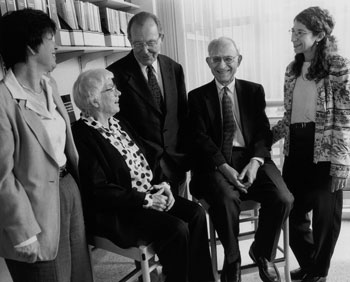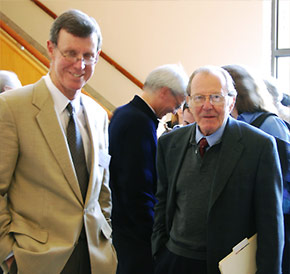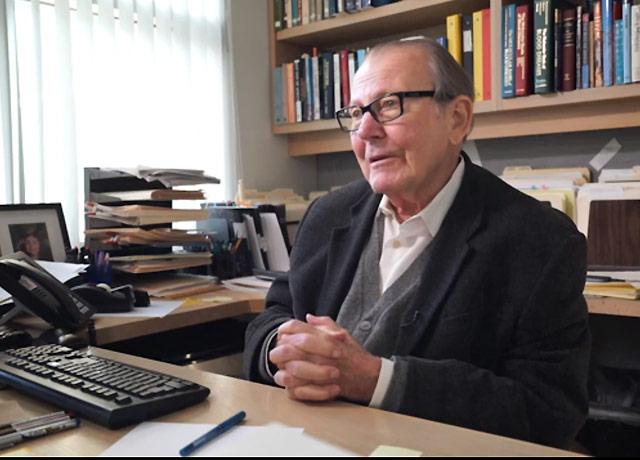
George Stamatoyannopoulos, pioneer of blood-disease research, dies
[Editor's note: Dr. George Stamatoyannopoulous, a University of Washington professor of medicine who pioneered the study of blood diseases, died June 16, 2018. This remembrance was submitted by the UW's Department of Medicine and Division of Medical Genetics.]
George Stamatoyannopoulos was born in Athens, Greece, on March 11, 1934. His childhood was shaped by the cataclysmic events that engulfed Greece between 1939-49, where a brutal Nazi occupation, famine, and ensuing bloody civil war scattered his family. Following the war he completed a classical education, studying science at night. He entered medical school in Athens at age 17, graduating top in his class.
Following his medical training, he pursued thesis research on inherited blood disorders, particularly anemias. He performed the first large-scale molecular geographical survey of a genetic trait, which strikingly revealed the relationship between malaria and both thalassemia and sickle cell traits. He also discovered that the fetal form of hemoglobin, which was re-awakened in some thalassemia patients, could ameliorate the effects of the disease. His theory that thalassemia and sickle cell anemia could be generally treated by re-activating fetal hemoglobin has underpinned decades of international effort to cure these disorders with drugs, gene therapies, and now gene editing.

As a young investigator he expanded genetic studies of blood diseases in Greece, where his work drew the attention of medical genetics pioneer Arno Motulsky, who recruited him to the University of Washington in 1964 with his wife and collaborator, Thalia Papayannopoulou. A full professor since 1973, he founded the Markey Molecular Medicine Center and was chief of medical genetics from 1989 to 2005.
Among his many lasting contributions was the creation of organizations and institutions to catalyze the advance of science. In 1978 he established a biennial meeting attracting hundreds of scientists at all levels involved in efforts to understand and cure red blood cell diseases using cutting-edge molecular approaches, and continued to serve as its co-organizer for nearly 40 years.
Foreseeing that genetic therapies represented a fundamentally new paradigm for treating disease that would escalate in importance as technologies progressed, he conceptualized and organized the founding of the American Society of Gene and Cell Therapy, now the pre-eminent scientific forum for a field numbering thousands of scientists spanning academia and biotechnology. His contributions were recognized by establishment of the Stamatoyannopoulos lecture, the society’s highest award.

He had an abiding concern for the careers of young investigators, and was a long-time mentor to many leading scientists around the world.
Dr. Stamatoyannopoulos received many honorary degrees and awards, including the Henry M. Stratton Medal for Distinguished Research in Hematology, the William Dameshek Prize of the American Society of Hematology, the Philip Levine Award of the American Society of Clinical Pathologists, and he was elected to numerous honorary organizations and academies. He also served as president of the American Society of Hematology (1992), president of the American Society of Gene and Cell Therapy (1996), and held leadership positions in national and international medical and scientific societies.
He authored over 420 scientific papers and 14 books, including The Molecular Basis of Blood Diseases, the first book of its kind to unite molecular advances across an entire field of medicine. His discoveries span many fundamental contributions to the study of blood diseases, gene regulation, gene therapy, and population genetic history. His industry and consistency of top-tier scientific output were remarkable; indeed, his first and last scientific papers were published in Nature, 55 years apart.
Dr. Stamatoyannopoulos was a scholar at heart with an enduring love of history and philosophy. He had passionately assembled one of the largest private collections in the world of early printed books comprising Renaissance and post-Renaissance editions of classical Greek and Byzantine authors.
He is survived by his wife and close collaborator of over 50 years, Thalia, a professor of medicine and internationally-recognized hematologist; two sons, one of whom is a professor of genome sciences and medicine and was a scientific collaborator in recent years; and three grandchildren.
He requested to be buried in his ancestral village near the Homeric town of Kyparissia, Greece.
For details about UW Medicine, please visit https://uwmedicine.org/about.
